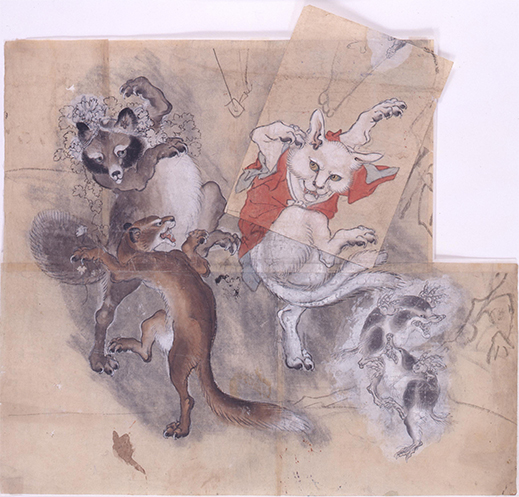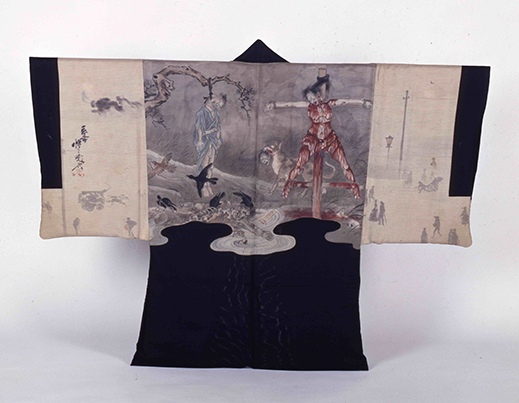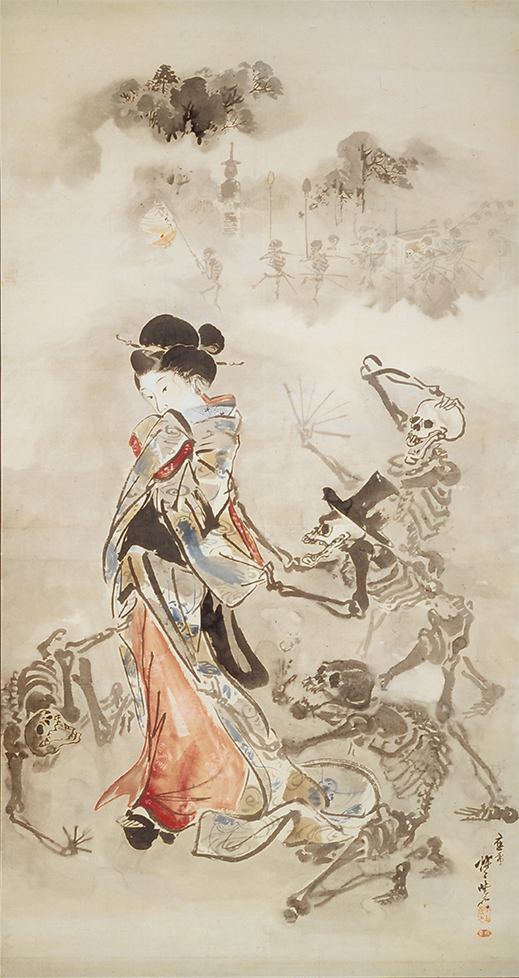 |
Focus features two in-depth reviews each month of fine art, architecture and design exhibitions and events at art museums, galleries and alternative spaces around Japan. The contributors are non-Japanese residents of Japan. |
|
|
 |
 |
 |
The Painting Demon: The Wondrous World of Kawanabe Kyosai
Christopher Stephens |
 |
In Front of the Paris Opera from The Strange Tale of the Castaways: A Western Kabuki (1879, Gas Museum collection; on view during the first half of the Kobe exhibition) |
Born in present-day Ibaraki Prefecture, Kawanabe Kyosai (1831-1889) was a painter and printmaker who studied with some of the greatest artists of his day, including Utagawa Kuniyoshi and members of the Kano school. Dubbing himself a "painting demon," Kyosai turned his hand to everything from advertisements to satirical caricatures, and dealt with subjects that ranged from charming animals at play to grisly scenes of violent death. Kyosai was one of the last masters of traditional Japanese art, but more importantly, as a figure who straddled the Edo and Meiji periods, he deftly infused the old with the new.
Rather than relying on a greatest-hits formula, a large part of the Kyosai Kawanabe exhibition (on view at the Hyogo Prefectural Museum of Art in Kobe through 19 May) is devoted to Kyosai's sources and production process. Drawing extensively on the collection of the Kawanabe Kyosai Memorial Museum, located in Saitama Prefecture north of Tokyo and overseen by the artist's great-granddaughter, the show comprises more than 200 works divided into two display periods (6-29 April and 30 April - 19 May).
Kyosai's source materials extended to secular and religious images from Western newspapers and magazines, such as the Illustrated London News and Harper's Weekly, and a map of the Central Pacific Railroad surrounded by scenic views of the Yosemite Valley and other sites in California. Prior to 1868, when Japan reopened to the outside world after more than 250 years of national seclusion, it would have been virtually impossible to obtain references of this kind.
 |
|
Frolicking Animals, Cat and Raccoon (preparatory drawing, Meiji period, Kawanabe Kyosai Memorial Museum collection; on view during the first half of the Kobe exhibition) |
The artist's working methods can be ascertained from his sketchbooks and preliminary drawings, some of which provided the basis for finished works. Others were simply exercises intended to help Kyosai achieve a better understanding of how things worked and how to convey the essence of a subject in the most concise and captivating manner. One fascinating example, Frolicking Animals, Cat and Raccoon, shows a group of animals (a "demon cat," a tanuki or raccoon dog, a weasel, and two moles) gathered in a loose circle in the midst of some feral dance, with teeth bared, gesticulating forepaws, and one hind leg thrust in the air. Pasted together out of two or three pieces of paper, the picture's right side has been cut out, and another sheet, depicting the upper portion of the cat's body, has been affixed at an angle over an earlier image of the animal. Rough brushstrokes in the background add a touch of depth without detail, while stray lines, blotches, and fragments of other drawings remain visible.
The exhibition includes several illustrations from The Strange Tale of the Castaways: A Western Kabuki, a play written by the dramatist Kawatake Mokuami (1816-1893). Very much of its time, the plot centers on a young fisherman and his father who are separated in a shipwreck. After being rescued by an American and English vessel, respectively, and surviving a series of adventures in foreign lands, the two are improbably reunited at an opera in Paris, whereupon they reflect on their experiences and remark on the kindness of strangers. Kyosai's In Front of the Paris Opera (1879) was among the works made by artists such as ukiyo-e master Tsukioka Yoshitoshi for decorative lanterns used around the theatre. This scene depicts the American consul-general and his wife dressed in their finery as they prepare to enter the opera house.
 |
|
Famous Sites in Tokyo, Overlooking Ueno Park (1881, Kawanabe Kyosai Memorial Museum collection; on view during the second half of the Kobe exhibition) |
Another sign of Japan's rapid Westernization was the presence of foreign artists among Kyosai's students and assistants. The most prominent of these was the British architect Josiah Conder (1852-1920), who arrived in Japan in 1877 to serve as an architectural adviser to the government and a professor at the University of Tokyo (a statue of him still stands on the campus). In addition to cultivating the first generation of Meiji architects, Conder designed a number of late 19th-century Tokyo landmarks such as the Rokumeikan (Deer Cry Pavilion, 1883), the site of Western-style balls and parties for visiting foreign dignitaries and well-heeled local residents; the original Nikolai Cathedral (1891), a Russian Orthodox church that was destroyed in the Great Kanto Earthquake of 1923; and the Mitsubishi Ichigokan (1894), which housed the eponymous company's banking division until it was torn down in 1968, only to be rebuilt as a museum in 2010. Conder's association with Kyosai is a lesser known facet of his career but remains highly significant, as his 1911 book Paintings and Studies by Kawanabe Kyosai provides a catalogue of the artist's works and a detailed explanation of his materials and methods. The architect is also present in Kyosai's work Famous Sites in Tokyo, Overlooking Ueno Park (1881), a panorama of the 2nd National Industrial Exhibition, held in 1881 in Ueno Park, with the newly opened, Conder-designed Ueno Museum (now the Tokyo National Museum) taking pride of place in the center of the print.
 |
|
Execution Site (1871-89, Kyoto Prefecture, deposited in the Museum of Kyoto; on view during the first half of the Kobe exhibition) |
For all the joy and humor in Kyosai's art, there is a distinctly grim (some might say brutally realistic) side to it. A series called Nine Stages of Decay, for example, delivers just what the title promises: the gradual disintegration of a human corpse. This Buddhist theme, a constant in Japanese art, was meant to help people come to terms with death and overcome their attachment to the physical world. Even more disturbing is Execution Site (1871-89), a scene of a crucified woman covered in blood, a dead man hanging from a tree limb, a dog with a severed head in its mouth, and several crows picking at the remains of a skeleton next to a pool, the shape of which spills into the black fabric ground of the haori (short overgarment) on which the picture was painted. The sleeves, on the other hand, bear a depiction of a foggy streetscape peopled with small silhouettes (some dressed in European attire), horse-drawn carriages, and gaslights, shorthand for Western technology. It was apparently popular at the time to sport haori decorated with unusual imagery, and the writing on the left sleeve indicates that the piece was order-made, but the exact intent behind the work remains obscure.
|
 |
|
|
|
Skeletons Seducing a Beauty (Meiji period, Stadtmuseum Hornmoldhaus Bietigheim-Bissingen [Germany] collection; on view throughout the Kobe exhibition)
|
Elsewhere, there are dark images of a slightly more comical nature, as in Skeletons Seducing a Beauty. Though presumably dead, several male skeletons (one sporting a top hat) appear to be just as lustful as they were in life, as they tug at the kimono of a passing woman, their mouths agape with unconcealed desire. Off in the distance, a parade of their cohorts marches through the trees, carrying what appears to be a box containing a gleaming white skull as if they might be welcoming a new arrival to the Kingdom of the Dead. Like these unforgettable figures, Kawanabe Kyosai's art transcends time and space, enduring as a pinnacle of the human imagination and artistic expression.
All works by Kawanabe Kyosai; all images provided by the Hyogo Prefectural Museum of Art. |
 |
 |
Christopher Stephens
Christopher Stephens has lived in the Kansai region for over 25 years. In addition to appearing in numerous catalogues for museums and art events throughout Japan, his translations on art and architecture have accompanied exhibitions in Spain, Germany, Switzerland, Italy, Belgium, South Korea, and the U.S. His recent published work includes From Postwar to Postmodern: Art in Japan 1945-1989: Primary Documents (MoMA Primary Documents, 2012) and Gutai: Splendid Playground (Solomon R. Guggenheim Museum, 2013). |
|
 |
|